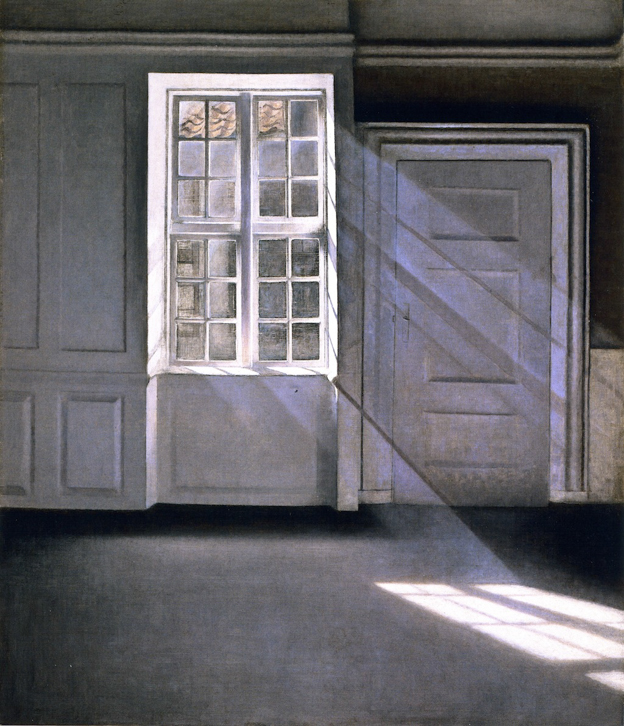The first time I saw a painting by Danish artist Vilhelm Hammershøi, I was at the Ordrupgaard Museum just outside of Copenhagen. My husband and I had walked through the main museum to see an exhibition on the sketches of Mary Cassatt. We had quickly gotten through that exhibit, the rest of the building and were on to the Vilhelm Hansen Estate home when I noticed Sunshine. Dust Motes Dancing in the Sunbeams (1900) above a mantle. It made me stop. It made me notice the light in the room.
“That’s the power of Hammershøi’s paintings, and it is why he is still relevant today,” Statens Museum for Kunst Senior Research Curator Kasper Monrad tells me. “His pictures demand that you sit down. Hammershøi is a kind of meditation.”
Born in Copenhagen, 1864, Hammershøi studied at the Royal Danish Academy of Fine Arts. He produced the bulk of his work in from the late 1880’s-1905 before experiencing a brief international popularity around 1910. He died shortly after, in 1916. After decades of obscurity, Hammershøi’s was re-established as a master in the 1980’s and his paintings now sell for massive sums. His works, oil paintings on canvas, focus on empty interiors with shafts of light or single people, often women, in quiet spaces. He works in muted colors – shades of grey, white, brown and black.
Though his wife (and in his earlier works, his sister) was a frequent model for his work, Monrad warns that we can’t take his use of her as an examination of their relationship.
“One shouldn’t relate Hammershøi’s subjects to him personally. He’s a symbolist, so his work is open to interpretation.” Monrad says. In other words, an empty room isn’t about the room; it’s an exploration of loneliness and isolation.
Some have translated that isolation to Hammershoi’s life, claiming that he didn’t seem to be interested in the art world at large. But Monrad says this is misconstrued based on the fact that his letters are often filled with the small missives and not much about the work of his peers. I’d like to point out that if 150 years from now someone used my letters (emails) to decipher what was important to me, they would have to conclude that I was extremely concerned with puppy gifs (I am).
In fact, Hammershøi apparently tried to meet James Abbot McNeill Whistler, to whom he is sometimes compared, on a trip to London. In addition, of the friends with whom he surrounded himself, some were known to be active in the art world while others wrote their own letters in which they told stories of visiting exhibits with Hammershøi himself. Though it may be no substitute for words from the man himself, it does show that he was aware of what was going on with his contemporaries.

Sunbeams

Interior with young man reading
When I ask about his influence, Monrad thinks for a moment. “People have asked me if Hammershøi is a direct influence on Edward Hopper. The truth is, we don’t know. We don’t have evidence that Hopper ever saw the work of Hammershøi.” This is disappointing for me, because the likeness to Hopper’s later pieces is the first thing I noticed in Hammershøi’s work. But influence doesn’t have to be linear, so perhaps there’s still a thread there. As for other Danish artists, Monrad tells me that there were a few painters directly after Hammershøi who worked in the same style, but none did it as well as Wilhelm.
Hammershøi’s body of work is often focused on light and the way it falls on surfaces. Kasper cites the argument that certain staging choices, such as a table directly next to a piano in the 1901 piece Interior, Strandgade 30, point to Hammershøi as a surrealist. After all, the arrangement makes no sense. But Monrad says this kind of conclusion misses the point. He notes: “In this painting, he wanted to show how the light looks on the top of the tablecloth. I don’t think it’s an attempt at surrealism.”
And Monrad should know. He’s studied Hammershøi for 15 years and has organized a major exhibition of his work: the wonderful 2013 Hammershøi and Europe at Statens Museum for Kunst. Currently, he’s coordinating efforts to bring a Hammershøi exhibition to New York City. We’ll be bringing you more on exciting event that soon!

Interior with piano and woman in black

Danish Ida in an interior with piano

Portrait of a Young Girl

Interior with young woman from behind
Some places you can see Hammershøi’s painting in person:
Statens Museum for Kunst (largest collection)
Sølvgade 48-50
1307 København K
Denmark
Ordrupgaard
Vilvordevej 110
2920 Charlottenlund
Denmark
The Hirschsprung Collection
Stockholmsgade 20
2100 København Ø
Denmark
The David Collection
Kronprinsessegade 30
1306 København K
Denmark
Tate Britain
Millbank
London SW1P 4RG
United Kingdom
Musée D’Orsay
1 Rue de la Légion d’Honneur
75007 Paris
France
Nationalmuseum Stockholm
Södra Blasieholmshamnen
Stockholm
Sweden
Do you have a favorite Danish artist? Tell us about him/her in the comments!

